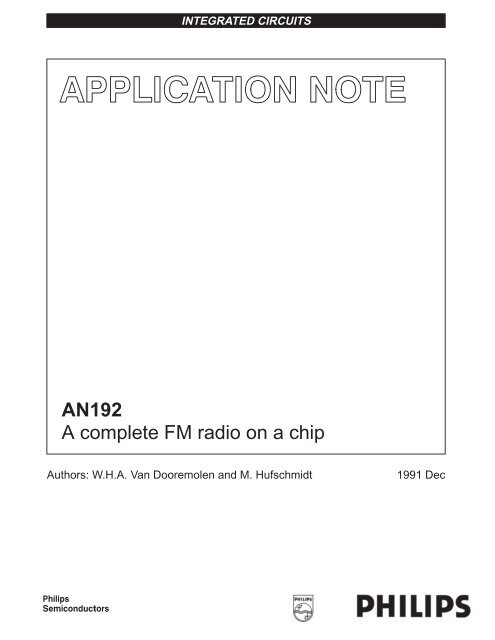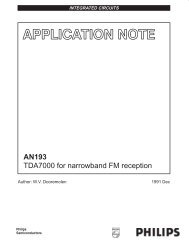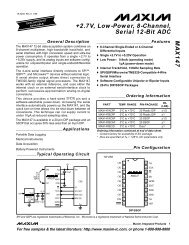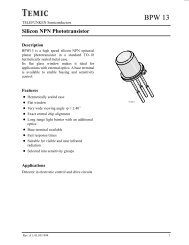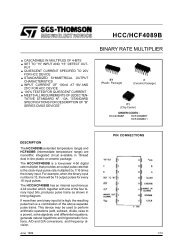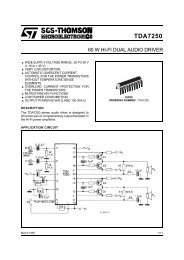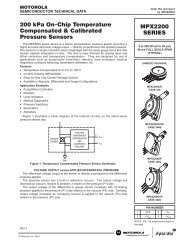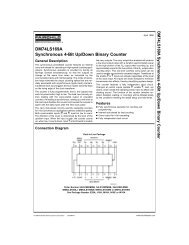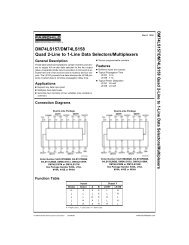AN192 A complete FM radio on a chip
AN192 A complete FM radio on a chip
AN192 A complete FM radio on a chip
You also want an ePaper? Increase the reach of your titles
YUMPU automatically turns print PDFs into web optimized ePapers that Google loves.
INTEGRATED CIRCUITS<str<strong>on</strong>g>AN192</str<strong>on</strong>g>A <str<strong>on</strong>g>complete</str<strong>on</strong>g> <str<strong>on</strong>g>FM</str<strong>on</strong>g> <str<strong>on</strong>g>radio</str<strong>on</strong>g> <strong>on</strong> a <strong>chip</strong>Authors: W.H.A. Van Dooremolen and M. Hufschmidt1991 Dec
Philips Semic<strong>on</strong>ductorsApplicati<strong>on</strong> noteA <str<strong>on</strong>g>complete</str<strong>on</strong>g> <str<strong>on</strong>g>FM</str<strong>on</strong>g> <str<strong>on</strong>g>radio</str<strong>on</strong>g> <strong>on</strong> a <strong>chip</strong><str<strong>on</strong>g>AN192</str<strong>on</strong>g>Authors: W.H.A.Van Dooremolen, M. HufschmidtUntil now, the almost total integrati<strong>on</strong> of an <str<strong>on</strong>g>FM</str<strong>on</strong>g> <str<strong>on</strong>g>radio</str<strong>on</strong>g> has beenprevented by the need for LC tuned circuits in the RF, IF, localoscillator and demodulator stages. An obvious way to eliminate thecoils in the IF and demodulator stages is to reduce the normallyused intermediate frequency of 10.7MHz to a frequency that can betuned by active RC filters, the op amps and resistors of which canbe integrated. An IF of zero deems to be ideal because it eliminatesspurious signals such as repeat spots and image resp<strong>on</strong>se, but itwould not allow the IF signal to be limited prior to demodulati<strong>on</strong>,resulting in poor signal-to-noise ratio and no AM suppressi<strong>on</strong>. Withan IF of 70kHz, these problems are overcome and the imagefrequency occurs about halfway between the desired signal and thecenter of the adjacent channel. However, the IF image signal mustbe suppressed and, in comm<strong>on</strong> with c<strong>on</strong>venti<strong>on</strong>al <str<strong>on</strong>g>FM</str<strong>on</strong>g> <str<strong>on</strong>g>radio</str<strong>on</strong>g>s, thereis also a need to suppress interstati<strong>on</strong> noise and noise when tunedto a weak signal. Spurious resp<strong>on</strong>ses above and below the centerfrequency of the desired stati<strong>on</strong> (side tunings), and harm<strong>on</strong>icdistorti<strong>on</strong> in the event of very inaccurate tuning must also beeliminated.We have now developed a m<strong>on</strong>o <str<strong>on</strong>g>FM</str<strong>on</strong>g> recepti<strong>on</strong> system which issuitable for almost total integrati<strong>on</strong>. It uses an active 70kHz IF filterand a unique correlati<strong>on</strong> muting circuit for suppressing spurioussignals such as side resp<strong>on</strong>ses caused by the flanks of thedemodulator S-curve. With such a low IF, distorti<strong>on</strong> would occur withthe ±75kHz IF swing due to received signals with maximummodulati<strong>on</strong>. The maximum IF swing is therefore compressed to±15kHz by c<strong>on</strong>trolling the local oscillator in a frequency-locked loop(FLL). The combined acti<strong>on</strong> of the muting circuit and the FLL alsosuppresses image resp<strong>on</strong>se.The new circuit is the TDA7000 which integrates a m<strong>on</strong>o <str<strong>on</strong>g>FM</str<strong>on</strong>g> <str<strong>on</strong>g>radio</str<strong>on</strong>g>all the way from the aerial input to the audio output. External to theIC are <strong>on</strong>ly <strong>on</strong>e tunable LC circuit for the local oscillator, a fewinexpensive ceramic plate capacitors and <strong>on</strong>e resistor. TheTDA7000 dramatically reduces assembly and post-producti<strong>on</strong>alignment costs because <strong>on</strong>ly the oscillator circuit needs adjustmentduring manufacture to set the limits of the tuned frequency band.The <str<strong>on</strong>g>complete</str<strong>on</strong>g> <str<strong>on</strong>g>FM</str<strong>on</strong>g> <str<strong>on</strong>g>radio</str<strong>on</strong>g> can be made small enough to fit inside acalculator, cigarette lighter, key-ring fob or even a slim watch. TheTDA7000 can also be used as receiver in equipment such ascordless teleph<strong>on</strong>es, CB <str<strong>on</strong>g>radio</str<strong>on</strong>g>s, <str<strong>on</strong>g>radio</str<strong>on</strong>g>-c<strong>on</strong>trolled models, pagingsystems, the sound channel of a TV set or other <str<strong>on</strong>g>FM</str<strong>on</strong>g> demodulatingsystems.Using the TDA7000 results in significant improvements for allclasses of <str<strong>on</strong>g>FM</str<strong>on</strong>g> <str<strong>on</strong>g>radio</str<strong>on</strong>g>. For simpler portables, the small size, lack of IFcoils, easy assembly and low power c<strong>on</strong>sumpti<strong>on</strong> are not the <strong>on</strong>lyattractive features. The unique correlati<strong>on</strong> muting system and theFLL make it very easy to tune, even when using a tiny tuning knob.For higher-performance portables and clock <str<strong>on</strong>g>radio</str<strong>on</strong>g>s,variable-capacitance diode tuning and stati<strong>on</strong> presetting facilities areoften required. These are easily provided with the TDA7000because there are no variable tuned circuits in the RF signal path.Only the local oscillator needs to be tuned, so tracking and distorti<strong>on</strong>problems are eliminated.The TDA7000 is available in either an 18-lead plastic DIP package(TDA7000), or in a 16-pin SO package (TDA7010T). Futuredevelopments will include reducing the present supply voltage (4.5Vtyp.), and the introducti<strong>on</strong> of <str<strong>on</strong>g>FM</str<strong>on</strong>g> stereo and AM/<str<strong>on</strong>g>FM</str<strong>on</strong>g> versi<strong>on</strong>s.Figure 1. A Laboratory Model of the TDA7000 in a Complete <str<strong>on</strong>g>FM</str<strong>on</strong>g> Radio.Also Shown is the TDA7010T in the SO Package Against a CM Scale.SR01154BRIEF DATASYMBOL DESCRIPTION MIN TYP MAX UNITSV CC Typical supply voltage 4.5 VI CC Typical supply current 8 mAf RF RF input frequency range 1.5 110 MHzV RF–3dB Sensitivity for –3dB limiting EMF with Z S = 75Ω, mute disabled 1.5 µVV RF Maximum signal input for THD < 10%, ∆f = ± 75kHz EMF with Z S = 75Ω 200 mVV O Audio output (RMS) with R L = 22kΩ, ∆f = ± 22.5kHz 75 mV1991 Dec2
Philips Semic<strong>on</strong>ductorsA <str<strong>on</strong>g>complete</str<strong>on</strong>g> <str<strong>on</strong>g>FM</str<strong>on</strong>g> <str<strong>on</strong>g>radio</str<strong>on</strong>g> <strong>on</strong> a <strong>chip</strong>Applicati<strong>on</strong> note<str<strong>on</strong>g>AN192</str<strong>on</strong>g>V P(+4.5V)C142.2nFC22C18C17C1547pFC23C12C11220pF330pF100nFL2 (2)39pF150pF3.3nF330pF130nHC10AP2+–18 17 16 15 14 13 12 11 101.4V(1)10kΩAP1+–2.7kΩ10kΩ+IF LIMITERAMPLIFIERIF FILTER4.7kΩ 4.7kΩTDA7000M3M2CORRELATOR<str<strong>on</strong>g>FM</str<strong>on</strong>g> DEMODULATOR13.6kΩAF1AM1+1MUTE2.2kΩ 2.2kΩmute c<strong>on</strong>trolIF FILTERVCOV LOOPPFILTERLA2NOISESOURCELOCAL OSC1 2 3 (1)4 5 6 7 8 9V P 56nHL1C7C12C2 C3C4R2C19 27pF3.3nFC5C8150nF22kΩ 1.8nF 22nF10nF10nFC21180pFC2056pFa.f. outputNOTES:1. These pins are not used in the SO package versi<strong>on</strong> (TDA7010T) AP = All-Pass filter.2. L 2 is printed <strong>on</strong> the experimental PCB (Figure 13).L 1 = Toko MC108 No. 514 HNE 150013S13.C 20 = Toko No.2A-15BT-R01.LA1Figure 2. The TDA7000 as a Variable Capacitor-Tuned <str<strong>on</strong>g>FM</str<strong>on</strong>g> Broadcast Receiver700Ω700ΩAF1B12kΩ –SR01155CIRCUIT DESCRIPTIONAs shown in Figure 2, the TDA7000 c<strong>on</strong>sists of a local oscillator anda mixer, a two-stage active IF filter followed by an IF limiter/amplifier,a quadrature <str<strong>on</strong>g>FM</str<strong>on</strong>g> demodulator, and an audio muting circuit c<strong>on</strong>trolledby an IF waveform correlator. The c<strong>on</strong>versi<strong>on</strong> gain of the mixer,together with the high gain of the IF limiter/amplifier, provides AVCacti<strong>on</strong> and effective suppressi<strong>on</strong> of AM signals. The RF input to theTDA7000 for –3dB limiting is 1.5µV. In a c<strong>on</strong>venti<strong>on</strong>al portable <str<strong>on</strong>g>radio</str<strong>on</strong>g>,limiting at such a low RF input level would cause instability becausehigher harm<strong>on</strong>ics of the clipped IF signal would be radiated to theaerial. With the low IF used with the TDA7000, the radiati<strong>on</strong> isnegligible.To prevent distorti<strong>on</strong> with the low IF used with the TDA7000, it isnecessary to restrict the IF deviati<strong>on</strong> due to heavily modulated RFsignals to ±15kHz. This is achieved with a frequency-locked loop(FLL) in which the output from the <str<strong>on</strong>g>FM</str<strong>on</strong>g> demodulator shifts the localoscillator frequency in inverse proporti<strong>on</strong> to the IF deviati<strong>on</strong> due tomodulati<strong>on</strong>.Active IF FilterThe first secti<strong>on</strong> of the IF filter (AF1A) is a sec<strong>on</strong>d-order low-passSallen-Key circuit with its cut-off frequency determined by internal2.2kΩ resistors and external capacitors C 7 and C 8 . The sec<strong>on</strong>dsecti<strong>on</strong> (AF1B) c<strong>on</strong>sists of a first-order bandpass filter with the lower1991 Dec 3
Philips Semic<strong>on</strong>ductorsA <str<strong>on</strong>g>complete</str<strong>on</strong>g> <str<strong>on</strong>g>FM</str<strong>on</strong>g> <str<strong>on</strong>g>radio</str<strong>on</strong>g> <strong>on</strong> a <strong>chip</strong>Applicati<strong>on</strong> note<str<strong>on</strong>g>AN192</str<strong>on</strong>g>limit of the passband determined by an internal 4.7kΩ resistor andexternal capacitor C 11 . The upper limit of the passband isdetermined by an internal 4.7kΩ resistor and external capacitor C 10 .The final secti<strong>on</strong> of the IF filter c<strong>on</strong>sists of a first-order low-passnetwork comprising an internal 12kΩ resistor and external capacitorC 12 . The overall IF filter therefore c<strong>on</strong>sists of a fourth-order low-passsecti<strong>on</strong> and a first-order high-pass secti<strong>on</strong>. Design equati<strong>on</strong>s for thefilter are given in Figure 3. Figure 4 shows the measured resp<strong>on</strong>sefor the filter.V o /V i(dB)+100–10–20–30–40R12.2kΩ7R12.2kΩ8C8AF1Ag1C7g1 = 0.99R24.7kΩ 10 +C10R2 11 –4.7kΩC11AF1BR312kΩ12C12–50–60–700 100 200 300 400 500f (kHz)Figure 4. Measured Resp<strong>on</strong>se of the IF FilterSR01157Sallen-Key Filter BP LPSallen-Key circuitgA SK1 j a 2 b1C 7With f Oand Q 0.5 C8A SK2 R 1 C7 C 8g1 jO 1 Q 2 2 OFor C 7 = 3.3nF, C 8 = 180pF; Q = 2.1 and f O = 94kHzBandpass circuitA BPFor f LP1j C 11R 21 j C 10R 2j C 10R 21 j C 11R 21 j C 10R 211and f2 R 2C HP102 R 2C 11f LP1A BP f HPff1 jf HP LP 1 jf 1For C 10 = 330pF, C 11 = 3.3nF, f LP = 103kHz, f HP = 10.3kHzLow-Pass circuit1A LP1 j C 12R 3for f LPA LP 1j LP12 C 12R 3<str<strong>on</strong>g>FM</str<strong>on</strong>g> DemodulatorThe quadrature <str<strong>on</strong>g>FM</str<strong>on</strong>g> demodulator M2 c<strong>on</strong>verts the IF variati<strong>on</strong>s dueto modulati<strong>on</strong> into an audio frequency voltage. It has a c<strong>on</strong>versi<strong>on</strong>gain of –3.6V/MHz and requires phase quadrature inputs from the IFlimiter/amplifier. As shown in Figure 5, the 90° phase shift isprovided by an active all-pass filter which has about unity gain at allfrequencies but can provide a variable phase shift, dependent <strong>on</strong> thevalue of external capacitor C 17 .V if– φR1V af+10kΩM2R22.7kΩto correlator17C17With R 2 = 0φ = –2tan –1 ωR 1 C 17for fi 90 o , C 17 1 227pF R 1for f L = 70kHzTo improve the performance of the all-pass filter with theamplitude-limited IF waveform, R 2 has been added.Since this influences the phase angle by 45%, i.e., to 330pFfor f IF = 70kHz.SR01158Figure 5. <str<strong>on</strong>g>FM</str<strong>on</strong>g> Demodulator Phase Shift Circuit (All-Pass Filter)For C 12 = 150pF, f LP = 88.4kHzFigure 3. IF Filter of the TDA7000SR011561991 Dec 4
Philips Semic<strong>on</strong>ductorsA <str<strong>on</strong>g>complete</str<strong>on</strong>g> <str<strong>on</strong>g>FM</str<strong>on</strong>g> <str<strong>on</strong>g>radio</str<strong>on</strong>g> <strong>on</strong> a <strong>chip</strong>Applicati<strong>on</strong> note<str<strong>on</strong>g>AN192</str<strong>on</strong>g>IF Swing Compressi<strong>on</strong> With the FLLWith a nominal IF as low as 70kHz, severe harm<strong>on</strong>ic distorti<strong>on</strong> ofthe audio output would occur with an IF deviati<strong>on</strong> of ±75kHz due tofull modulati<strong>on</strong> of a received <str<strong>on</strong>g>FM</str<strong>on</strong>g> broadcast signal. The FLL of theTDA7000 is therefore used to compress the IF swing by using theaudio output from the <str<strong>on</strong>g>FM</str<strong>on</strong>g> demodulator to shift the local oscillatorfrequency in oppositi<strong>on</strong> to the IF deviati<strong>on</strong>. The principle is illustratedin Figure 6, which shows how an IF deviati<strong>on</strong> of 75kHz iscompressed to about 15kHz. The THD is thus limited to 0.7% with±22.5kHz modulati<strong>on</strong>, and to 2.3% with ±75kHz modulati<strong>on</strong>.there are two side resp<strong>on</strong>ses due to the flanks of the demodulatorS-curve. Because the flanks of the S-curve are n<strong>on</strong>-linear, the sideresp<strong>on</strong>ses have increased harm<strong>on</strong>ic distorti<strong>on</strong>. In Figure 7, thefrequency and intensity of the side resp<strong>on</strong>ses are functi<strong>on</strong>s of thesignal strength, and they are separated from the correct tuning pointby amplitude minima. However, in practice, the amplitude minimaare not well defined because the modulati<strong>on</strong> frequency and indexare not c<strong>on</strong>stant and, moreover, the side resp<strong>on</strong>se of adjacentchannels often overlap.V af200kHzV rf = 10mVf rfMIXER ANDI.F. AMPLIFIERf ifF.M.DEMODULATOR(CONVERSIONGAIN D =–3.6V/MHz)V afV af1mVfoscC17330pFVOLTAGE–LOOP AMPLIFIER56nHCextCONTROLLEDLOCAL OSC.Cdiode (SLOPE S =–1.14pF/V)A L = –1.06V af 100µVC O = C EXT + C STRAY + C DIODE with open loop = 49pF at f O = 96MHzA LSf OFeedback factor 2 C OOpen-loop c<strong>on</strong>versi<strong>on</strong> gain = D = –3.6V/MHzClosed loop c<strong>on</strong>versi<strong>on</strong> gain D1 D 0.68VMHz for f O 96MHzV af 10µVModulati<strong>on</strong> compressi<strong>on</strong> factor k f OSC f RF 1 1K open loop gainclosed loop gain 3.6VMHz0.684VMHz f RF f IF Kfor f RF 75kHz, f 60kHz, f OSC IF 15kHz∆f if = 85 – 70 = 15kHz 5V af 3µVV af1.5µVf OSC = f Of’ OSC f rf∆f OSC = 60kHzf if = 70kHzf’ rf∆f rf = 75kHzf’ rf = 85kHzV af 1µV95.9 95.93 95.99 96 96.075 96.1f rf (kHz)SR01159Figure 6. IF Swing Compressi<strong>on</strong> with the FLLV afenlarged invertical directi<strong>on</strong>0.7µVCorrelati<strong>on</strong> Muting System With Open FLLA well-known difference between <str<strong>on</strong>g>FM</str<strong>on</strong>g> and AM is that, for <str<strong>on</strong>g>FM</str<strong>on</strong>g>, eachstati<strong>on</strong> is received in at least three tuning positi<strong>on</strong>s. Figure 7 showsthe frequency spectrum of the output from the demodulator of atypical portable <str<strong>on</strong>g>FM</str<strong>on</strong>g> <str<strong>on</strong>g>radio</str<strong>on</strong>g> receiving an RF carrier frequency-modulatedwith a t<strong>on</strong>e of c<strong>on</strong>stant frequency and amplitude. In additi<strong>on</strong> to theaudio resp<strong>on</strong>se at the correct tuning point in the center of Figure 7,SR01160Figure 7. Audio Signal of a Typical Portable Radio as aFuncti<strong>on</strong> of Tuned Frequency With RF Input as a Parameter.The Modulati<strong>on</strong> and Amplitude are Both C<strong>on</strong>stant.1991 Dec 5
Philips Semic<strong>on</strong>ductorsA <str<strong>on</strong>g>complete</str<strong>on</strong>g> <str<strong>on</strong>g>FM</str<strong>on</strong>g> <str<strong>on</strong>g>radio</str<strong>on</strong>g> <strong>on</strong> a <strong>chip</strong>Applicati<strong>on</strong> note<str<strong>on</strong>g>AN192</str<strong>on</strong>g>High performance <str<strong>on</strong>g>FM</str<strong>on</strong>g> <str<strong>on</strong>g>radio</str<strong>on</strong>g>s incorporate squelch systems such assignal strength-dependent muting and tuning deviati<strong>on</strong>-dependentmuting to suppress side resp<strong>on</strong>ses. They also have a tuning meterto facilitate correct tuning. Although the TDA7000 is mainly intendedfor use in portables and clock <str<strong>on</strong>g>radio</str<strong>on</strong>g>s, it incorporates a very effectivenew correlati<strong>on</strong> muting system which suppresses interstati<strong>on</strong> noiseand spurious resp<strong>on</strong>ses due to detuning to the flanks of thedemodulator S-curve. The muting system is c<strong>on</strong>trolled by a circuitwhich determines the correlati<strong>on</strong> between the waveform of the IFsignal and an inverted versi<strong>on</strong> of it which is delayed (phase-shifted)by half the period of the nominal IF (180°). A noise generator worksin c<strong>on</strong>juncti<strong>on</strong> with the muting system to give an audible indicati<strong>on</strong>High performance <str<strong>on</strong>g>FM</str<strong>on</strong>g> <str<strong>on</strong>g>radio</str<strong>on</strong>g>s incorporate squelch systems such assignal strength-dependent muting and tuning deviati<strong>on</strong>-dependentmuting to suppress side resp<strong>on</strong>ses. They also have a tuning meterto facilitate correct tuning. Although the TDA7000 is mainly intendedfor use in portables and clock <str<strong>on</strong>g>radio</str<strong>on</strong>g>s, it incorporates a very effectivenew correlati<strong>on</strong> muting system which suppresses interstati<strong>on</strong> noiseand spurious resp<strong>on</strong>ses due to detuning to the flanks of thedemodulator S-curve. The muting system is c<strong>on</strong>trolled by a circuitwhich determines the correlati<strong>on</strong> between the waveform of the IFsignal and an inverted versi<strong>on</strong> of it which is delayed (phase-shifted)by half the period of the nominal IF (180°). A noise generator worksin c<strong>on</strong>juncti<strong>on</strong> with the muting system to give an audible indicati<strong>on</strong> ofincorrect tuning.Figure 8 illustrates the functi<strong>on</strong> of the muting system. Signal IF’ isderived by delaying the IF signal by half the period of the nominal IFand inverting it. With correct tuning as shown in Figure 8a, thewaveforms of the two signals are identical, resulting in largecorrelati<strong>on</strong>. In this situati<strong>on</strong>, the audio signal is not muted. Withdetuning as shown in Figure 8b, signal IF ’ is phase-shifted withrespect to the IF signal. The correlati<strong>on</strong> between the two waveformsis therefore small and the audio output is muted. Figure 8c showsthat, because of the low Q of the IF filter, noise causes c<strong>on</strong>siderablefluctuati<strong>on</strong>s of the period of the IF signal waveform. There is thensmall correlati<strong>on</strong> between the two waveforms and the audio ismuted. The correlati<strong>on</strong> muting system thus suppresses noise andside resp<strong>on</strong>ses due to detuning to the flanks of the demodulatorS-curve. Since the mute threshold is much lower than that obtainedwith most other currently-used muting systems, this muting systemis ideal for portable <str<strong>on</strong>g>radio</str<strong>on</strong>g>s which must often receive signals with alevel <strong>on</strong>ly slightly above the input noise.largecorrelati<strong>on</strong>withcorrecttuningI.F.I.F.’(a)As shown in Figure 9, the correlati<strong>on</strong> muting circuit c<strong>on</strong>sists ofall-pass filter AP2 c<strong>on</strong>nected in series with <str<strong>on</strong>g>FM</str<strong>on</strong>g> demodulator all-passfilter AP1 and adjusted by an external capacitor to provide a totalphase shift of 180°. The output from AP2 is applied to mixer M3which determines the correlati<strong>on</strong> between the undelayed limited IFsignal at <strong>on</strong>e of its inputs and the delayed and inverted versi<strong>on</strong> of itat its other input. The output from mixer M3 c<strong>on</strong>trols a muting circuitwhich feeds the demodulated audio signal to the output when thecorrelati<strong>on</strong> is high, or feeds the output from a noise source to theoutput to give an audible indicati<strong>on</strong> of incorrect tuning when thecorrelati<strong>on</strong> is low. The switching of the muting circuit is progressive(soft muting) to prevent the generati<strong>on</strong> of annoying audio transients.The output from mixer M3 is available externally at Pin 1 and canalso used to drive a detuning indicator.V if<str<strong>on</strong>g>FM</str<strong>on</strong>g>DEMODULATORV ifALL-PASSFILTER(Fig 4)φ 1 =–90°– φR1+ φ 2 =10kΩ–180°18C18 2 2 tan 1 R 1C 18 1for 2 180 o C 18 1 R 1for f if 70kHz,C 18 227pFFigure 9. Correlator of the TDA7000M3mutec<strong>on</strong>trol1C1SR01162Figure 10 shows that there are two regi<strong>on</strong>s where the demodulatedaudio signal is fed to the output because the muting is inactive. Oneregi<strong>on</strong> is centered <strong>on</strong> the correct tuning point f L . The other iscentered <strong>on</strong> the image frequency –f L . The image resp<strong>on</strong>se istherefore not suppressed by the muting system when thefrequency-locked loop is open. When the loop is closed, the timec<strong>on</strong>stant of the muting system, which is determined by externalcapacitor C 1 , prevents the image resp<strong>on</strong>se being passed to theaudio output. This is described under the next heading.smallcorrelati<strong>on</strong>due todetuningI.F.I.F.’(b)very smallcorrelati<strong>on</strong>due t<strong>on</strong>oiseI.F.I.F.’(c)SR01161Figure 8. Functi<strong>on</strong> of the Correlati<strong>on</strong> Muting System1991 Dec 6
Philips Semic<strong>on</strong>ductorsA <str<strong>on</strong>g>complete</str<strong>on</strong>g> <str<strong>on</strong>g>FM</str<strong>on</strong>g> <str<strong>on</strong>g>radio</str<strong>on</strong>g> <strong>on</strong> a <strong>chip</strong>Applicati<strong>on</strong> note<str<strong>on</strong>g>AN192</str<strong>on</strong>g>Vlock transient A during the short interval while the IF traverses from–f 2 to –f 1 . Since the image resp<strong>on</strong>se occurs halfway between –f 1and –f 2 , it is also suppressed.<str<strong>on</strong>g>FM</str<strong>on</strong>g> demodulatoroutput voltagelocal oscillatorc<strong>on</strong>trol voltagecorrelatoroutput voltageONmute functi<strong>on</strong>OFFsidetuningimageresp<strong>on</strong>se0V0V0V0correcttuning(a)f f rf osc(b)f f rf osc(c)f f rf osc(d)f f rf oscFigure 12 shows the audio output from the TDA7000 <str<strong>on</strong>g>radio</str<strong>on</strong>g> as afuncti<strong>on</strong> of tuned frequency with aerial signal level as a parameter.Compared with the similar diagram for a typical c<strong>on</strong>venti<strong>on</strong>alportable <str<strong>on</strong>g>radio</str<strong>on</strong>g> (Figure 7), there are three important improvements:1. There are no side resp<strong>on</strong>ses due to the flanks of the demodulatorS-curve. This is due to the acti<strong>on</strong> of the correlati<strong>on</strong> muting system(soft mute) which combines the functi<strong>on</strong> of a detuning-dependentmuting system with that of a signal strength-dependent mutingsystem.2. The correct tuning frequency band is wide, even with weak aerialsignals. This is due to the AFC acti<strong>on</strong> of the FLL which reduces alarge variati<strong>on</strong> of aerial input frequency (equivalent to detuning) to asmall variati<strong>on</strong> of the IF. There is no audio distorti<strong>on</strong> when the <str<strong>on</strong>g>radio</str<strong>on</strong>g>is slightly detuned.3. Although the soft muting system remains operative with low levelaerial signals, there is no degradati<strong>on</strong> of the audio signal underthese c<strong>on</strong>diti<strong>on</strong>s. This is due to the high gain of the IFlimiter/amplifier which provides –3dB limiting of the IF signal with anaerial input level of 1.5µV. However, the soft muting acti<strong>on</strong> doesreduce the audio output level with low level aerial signals.audiooutput voltagewith‘soft’ mutingimageside tuningsuppressedcorrecttuning f 1 f 2f 1f 2SR01163f rf f osc(e)∆f OSC≈ ∆ V Of rf f oscFigure 10. Operati<strong>on</strong> of the Correlati<strong>on</strong> Muting System withOpen-Loop FLLCorrelati<strong>on</strong> Muting System With Closed FLLThe closed-loop resp<strong>on</strong>se of the FLL is shown in Figure 11, in whichthe point of origin is the nominal IF (f RF –f OSC =f L ). With correcttuning, the muting is inactive and the audio signal is fed to theoutput. Spurious resp<strong>on</strong>ses due to the flanks of the demodulatorS-curve which occur outside the IF band –f 2 to f 2 are suppressedbecause the muting is active. Fast transients of the audio signal dueto locking of the loop (A and B), and to loss of lock (C and D) aresuppressed in two ways.Lock and loss of lock transients B and D occur when the IF isgreater than f 2 and are therefore suppressed because the muting isactive. The situati<strong>on</strong> is different during loss of lock transient Cbecause the muting is <strong>on</strong>ly active for the last part of the transient. To<str<strong>on</strong>g>complete</str<strong>on</strong>g>ly suppress this transient, capacitor C 1 in Figure 2 holdsthe muting c<strong>on</strong>trol line positive (muting active) during the shortinterval while the IF traverses from –f 1 to –f 2 . The same applies forincorrectside tuningsuppressedCAholding rangecapture rangeB= area of correct tuningD∆f rfSR01164Figure 11. Closed-Loop Resp<strong>on</strong>se of the FLL1991 Dec 7
Philips Semic<strong>on</strong>ductorsA <str<strong>on</strong>g>complete</str<strong>on</strong>g> <str<strong>on</strong>g>FM</str<strong>on</strong>g> <str<strong>on</strong>g>radio</str<strong>on</strong>g> <strong>on</strong> a <strong>chip</strong>Applicati<strong>on</strong> note<str<strong>on</strong>g>AN192</str<strong>on</strong>g>V afV afV afV afV af200kHzV rf = 10mV1mV100µV10µV3µVtuned frequencySL01165Figure 12. Audio Signal of the TDA7000 as a Functi<strong>on</strong> of theTuned Frequency with RF Input as a ParameterRECEIVER CIRCUITSCircuits With Variable Capacitor TuningThe circuit diagram of the <str<strong>on</strong>g>complete</str<strong>on</strong>g> m<strong>on</strong>o <str<strong>on</strong>g>FM</str<strong>on</strong>g> <str<strong>on</strong>g>radio</str<strong>on</strong>g> is given inFigure 2. An experimental printed-wiring board layout is given inFigure 13. Special attenti<strong>on</strong> has been paid to supply lines and thepositi<strong>on</strong>ing of large-signal decoupling capacitors.The functi<strong>on</strong>s of the peripheral comp<strong>on</strong>ents of Figure 2 not alreadydescribed are as follows:C 1 – Determines the time c<strong>on</strong>stant required to ensure muting ofaudio transients due to the operati<strong>on</strong> of the FLL.C 2 – Together with R 2 determines the time c<strong>on</strong>stant for audiode-emphasis (e.g., R 2 C 2 = 40µs.C 3 – The output level from the noise generator during mutingincreases with increasing value of C 3 . If silent mute is required, C 3can be omitted.C 4 – Capacitor for the FLL filter. It eliminates IF harm<strong>on</strong>ics at theoutput of the <str<strong>on</strong>g>FM</str<strong>on</strong>g> demodulator. It also determines the time c<strong>on</strong>stantfor locking the FLL and influences the frequency resp<strong>on</strong>se.C 5 – Supply decoupling capacitor which must be c<strong>on</strong>nected as closeas possible to Pin 5 of the TDA7000.C 7 to C 12 , C 17 and C 18 – Filter and demodulator capacitors. Thevalues shown are for an IF of 70kHz. For other intermediatefrequencies, the values of these capacitors must be changed ininverse proporti<strong>on</strong> to the IF change.C 14 – Decouples the reverse RF input. It must be c<strong>on</strong>nected to thecomm<strong>on</strong> return via a good quality short c<strong>on</strong>necti<strong>on</strong> to ensure alow-impedance path. Inductive or capacitive coupling between C 14and the local oscillator circuit or IF output comp<strong>on</strong>ents must beavoided.C 15 – Decouples the DC feedback for IF limiter/amplifier LA 1 .C 19 and C 21 – Local oscillator tuning capacitors. Their valuesdepend <strong>on</strong> the required tuning range and <strong>on</strong> the value of tuningcapacitor C 20 .C 22 , C 23 , L 1 , L 2 – The values given are for an RF bandpass filterwith Q = 4 for the European and USA domestic <str<strong>on</strong>g>FM</str<strong>on</strong>g> broadcast band(87.5MHz to 108MHz). For recepti<strong>on</strong> of the Japanese <str<strong>on</strong>g>FM</str<strong>on</strong>g> broadcastband (76MHz to 91MHz), L 1 must be increased to 78nH and L 2must be increased to 150nH. If stopband attenuati<strong>on</strong> for high levelAM or TV signals is not required, L 2 and C 22 can be omitted and C 23changed to 220pF.R 2 – The load for the audio output current source. It determines theaudio output level, but its value must not exceed 22kΩ for V CC =4.5V, or 47kΩ for V CC = 9V.1991 Dec 8
Philips Semic<strong>on</strong>ductorsApplicati<strong>on</strong> noteA <str<strong>on</strong>g>complete</str<strong>on</strong>g> <str<strong>on</strong>g>FM</str<strong>on</strong>g> <str<strong>on</strong>g>radio</str<strong>on</strong>g> <strong>on</strong> a <strong>chip</strong><str<strong>on</strong>g>AN192</str<strong>on</strong>g>V O(dB)(75mV) 0S + N–20221V rf75Ω220pF220pF1314TDA7000–401NOISETHDTHD(%)105–6010 –6 10 –5 10 –4 10 –3 10 –2 10 –1 1V rf (e.m.f.)0NOTES:The curves numbered 1 were measured with the muting system active. The curves numbered 2 were measured with the muting system disabled by injecting about 20µA intoPin 1 of the TDA7000. The input frequency was 96MHz modulated with 1kHz with a deviati<strong>on</strong> of ±75kHz for the distorti<strong>on</strong> curve.Figure 13. Audio Output as a Functi<strong>on</strong> of Input EMFSR01166PERFORMANCE OF THE CIRCUITV CC =4.5V, T A =25°C f RF =96MHz, V RF =0.2mV EMF from a 75Ω source, modulated with ∆f=±22.5kHz, f M =1kHz. Noise voltagemeasured unweighted over the bandwidth 300Hz to 20kHz, unless otherwise specified.SYMBOL PARAMETER TYP MAXEMFEMFEMFEMFSensitivity (EMF voltage)for –3dB limiting:muting disabledfor –3dB mutingfor (S+N)/N=26dBSignal handling (EMF voltage)for THD
Philips Semic<strong>on</strong>ductorsA <str<strong>on</strong>g>complete</str<strong>on</strong>g> <str<strong>on</strong>g>FM</str<strong>on</strong>g> <str<strong>on</strong>g>radio</str<strong>on</strong>g> <strong>on</strong> a <strong>chip</strong>Applicati<strong>on</strong> note<str<strong>on</strong>g>AN192</str<strong>on</strong>g>Circuit With Variable-Capacitance Diode TuningSince it is <strong>on</strong>ly necessary to tune the local oscillator coil, it is verysimple to modify the circuit of Figure 2 for variable-capacitancediode tuning. The modificati<strong>on</strong>s are shown in Figure 14. A circuitboard layout for the modified receiver and a photograph of a<str<strong>on</strong>g>complete</str<strong>on</strong>g> laboratory model are shown in Figure 15.V P(4.5V)100kΩ82ΩBZX793VO5.6kΩ10nF3.3nFPIN 5BC558V tune100kΩ(log)10kΩ56nHTDA7000(Figure 2)300kΩ1.5kΩBB809PIN 60VPIN 16Figure 14. Variable-Capacitance Diode Tuning for the Local Oscillator.Additi<strong>on</strong>al Measures Must be Taken to Ensure Temperature Stability.SR01167100kΩ1.5kΩ300kΩ10nFBZX795.6kΩ10kΩBC55882kΩBB809L13.3nF56nHC8 C7C19C5 C4 C3C109TDA7000110 18L2C12 C22C11 C23 C14C15C17C1C2C18100kΩR2a.f. output+0VL2Figure 15. Circuit Board Layout and Complete Model of a TDA7000 Radio With Variable-Capacitance Diode TuningSL011681991 Dec 10
Philips Semic<strong>on</strong>ductorsA <str<strong>on</strong>g>complete</str<strong>on</strong>g> <str<strong>on</strong>g>FM</str<strong>on</strong>g> <str<strong>on</strong>g>radio</str<strong>on</strong>g> <strong>on</strong> a <strong>chip</strong>Applicati<strong>on</strong> note<str<strong>on</strong>g>AN192</str<strong>on</strong>g>Narrow-Band <str<strong>on</strong>g>FM</str<strong>on</strong>g> ReceiverThe TDA7000 can also be used for recepti<strong>on</strong> of narrowband <str<strong>on</strong>g>FM</str<strong>on</strong>g>signals. In this case, the local oscillator is crystal-c<strong>on</strong>trolled (asshown in Figure 16) and there is therefore hardly any compressi<strong>on</strong>of the IF swing by the FLL. The deviati<strong>on</strong> of the transmitted carrierfrequency due to modulati<strong>on</strong> must therefore be limited to preventsevere distorti<strong>on</strong> of the demodulated audio signal.The comp<strong>on</strong>ent values in Figure 17 result in an IF of 4.5kHz and anIF bandwidth of 5kHz (Figure 17). If the IF is multiplied by N, thevalues of capacitors C 17 and C 18 in the all-pass filters and thevalues of filter capacitors C 7 , C 8 , C 10 , C 11 , and C 12 must bemultiplied by 1/N. For improved IF selectivity to achieve greateradjacent channel attenuati<strong>on</strong>, sec<strong>on</strong>d-order networks can be used inplace of C 10 and C 11 .In this circuit the detuning noise generator is not used. Since thecircuit is mainly for recepti<strong>on</strong> of audio signals, the audio output mustbe passed through a low-pass Chebyshev filter to suppress IFharm<strong>on</strong>ics.r.f. input+4.5VC183.9nFC174.7nFC154.7µFC23220pFC123.3nFC11100nFC10C144.7nF220pF18 17 16 15 14 13 12 11 10TDA7000(see Fig. 1)9 8 7 6 5 4 3 2 1C1150nFR222kΩC22.7nFC44.7nFC5100nFC7100nFC82.2nFa.f. output200mV RMSSR01169Figure 16. A Narrowband <str<strong>on</strong>g>FM</str<strong>on</strong>g> Receiver With a Crystal-C<strong>on</strong>trolled Local OscillatorV+20i20 logV o +10(dB)0–105kHz3dB25dB–20–30–40–50–600 5 10 15 20f (kHz)SR01170Figure 17. IF Selectivity for the Narrowband <str<strong>on</strong>g>FM</str<strong>on</strong>g> Receiver1991 Dec 11
Philips Semic<strong>on</strong>ductorsA <str<strong>on</strong>g>complete</str<strong>on</strong>g> <str<strong>on</strong>g>FM</str<strong>on</strong>g> <str<strong>on</strong>g>radio</str<strong>on</strong>g> <strong>on</strong> a <strong>chip</strong>Applicati<strong>on</strong> note<str<strong>on</strong>g>AN192</str<strong>on</strong>g>AUDIO AMPLIFIER AND DETUNING INDICATORCIRCUITSAudio output stages suitable for use with the TDA7000 are shown inFigures 18 and 19. Figure 20 shows how the muting signal can beused to operate an LED to give an indicati<strong>on</strong> of detuning.+3V220kΩ1nF65Ωearpiecefrom Pin 2TDA70000V1) 1)22kΩ4.7nFBC550BP O = 0.4mW, d = 10%quiescent current = 4mASR01171Figure 18. A 0.4mW Transistor Audio Output Stage WithoutVolume C<strong>on</strong>trol for Driving an Earpiece+4.5Vto Pin 5TDA700022Ω220µF+85 3TDA1011APREAMPPOWERAMP42V A+220µFfrom Pin 2TDA70001)1)22kΩ95.6kΩ7100nF614.7Ω8Ω0V4.7nF(log)1.8nF0.1µFNOTE:1. These comp<strong>on</strong>ents replace C2 and R2 in Figure 2. P O = 250mW, d = 10% quiescent current = 8mA.Figure 19. An Integrated 250mW Audio Output StageSR01172+3Vfrom Pin 1of theTDA7000(Fig. 1)0V470kΩBC558SR01173Figure 20. A Detuning Indicator Driven by the Mute SignalFrom the TDA7000ACKNOWLEDGEMENTSThe authors wish to acknowledge the informati<strong>on</strong> provided byD. Kasperkovitz and H.v. Rumpt for incorporati<strong>on</strong> in this article.REFERENCENOW, W. and SIEWERT, I., ”Integrated circuitsfor hi-fi <str<strong>on</strong>g>radio</str<strong>on</strong>g>s andtuners’, Electr<strong>on</strong>ic Comp<strong>on</strong>entsand Applicati<strong>on</strong>s, Vol. 4, No. 1,November 1981,pp. 11 to 27.1991 Dec 12
Philips Semic<strong>on</strong>ductorsA <str<strong>on</strong>g>complete</str<strong>on</strong>g> <str<strong>on</strong>g>FM</str<strong>on</strong>g> <str<strong>on</strong>g>radio</str<strong>on</strong>g> <strong>on</strong> a <strong>chip</strong>Applicati<strong>on</strong> note<str<strong>on</strong>g>AN192</str<strong>on</strong>g>NOTES1991 Dec 13


